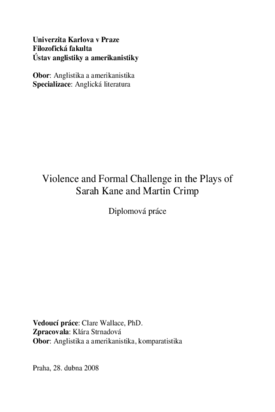Violence and formal challenge in the plays of Sarah Kane and Martin Crimp
Formální inovace a fenomén násilí v dramatech Sarah Kane a Martina Crimpa
diploma thesis (DEFENDED)

View/
Permanent link
http://hdl.handle.net/20.500.11956/15097Identifiers
Study Information System: 59492
Collections
- Kvalifikační práce [22841]
Author
Advisor
Referee
Pilný, Ondřej
Faculty / Institute
Faculty of Arts
Discipline
English and American Studies - Comparative Literature
Department
Department of Anglophone Literatures and Cultures
Date of defense
21. 5. 2008
Publisher
Univerzita Karlova, Filozofická fakultaLanguage
English
Grade
Excellent
Diplomová práce se zabývá divadelní tvorbou dvou predních britských dramatiku soucasnosti: Sarah Kane a Martina Crimpa. Zatímco krátký život Sarah Kane byl dramatický a témer všechny její hry vzbudily kontroverze, Crimp, který je o generaci starší, zustává v panoramatu britského divadla ponekud opomíjen. Kane považovala Crimpuv vliv, zejména na své pozdejší hry, za zásadní. V diplomové práci se zabýváme srovnáním techto dvou autoru z ruzných duvodu. Oba zanícene inovují tvar dramatického díla. Jejich hry se postupne oproštují od všeho, co jsme zvyklí si s divadelní hrou spojovat: není urcen cas ani místo, ale ani postavy ci príbeh nejsou jasne dány. Zatímco Crimp strídá hry prísne tradicní, konverzacní dramata ze soucasnosti (The Country), s experimenty bez postav a bez príbehu (Attempts on Her Life), Kane se jasne vyvíjela od jen mírne narušené tradicní formy (Phaedra's Love) pres avantgardní experiment (Cleansed) až po postmoderní, fragmentovaný text, který divadelní hru pripomíná jen vnejším tvarem (Crave, 4.48 Psychosis). Práce poskytuje shrnutím obsahu her možnost proniknout do jejich dramatického sveta i ctenári s dílem neobeznámenému. Následuje analýza del Crimpa a Kane vzhledem k aristotelským kritériím, zvlášte mimezi a katarzi. Zatímco Kane klasický mimetický tvar narušuje a ukazuje tím na jeho...
Both Crimp and Kane are genuine innovators of the dramatic form. The issues dealt with in their works are related; they share similar concerns about the dangers of nowadays' society - and, with it, theatre. This might not be apparent at first sight because of the divergence of styles. Crimp's style is language-centred, hyper-realistic at times, drawing a lot from the theatre of the absurd. He provides a characteristic mixture of satirical edge, ironic detachment and hidden threat. While Crimp works exclusively with the contemporary sensibility, Kane's proximity to the tradition of tragedy can be seen in what she employs in her plays - the big passions, "love, hate, death, revenge, suicide."1 Kane differs from both modernists and postmodernists by her refusal of detachment and by her requirement of emotional involvement. Both the playwright and her characters are absolutist, truth-seeking and provocative. Crimp prevents emotional identification even in the plays that at first sight seem realistic; in the experimental dramas, the distancing device of having stories narrated rather than just shown "allows Crimp to mix acerbic satire with rapid shifts of tone and focus,"2 asking intellectual questions in a convincingly dramatic form. The intense emotional content, which in Kane is delivered by the explicit,...
